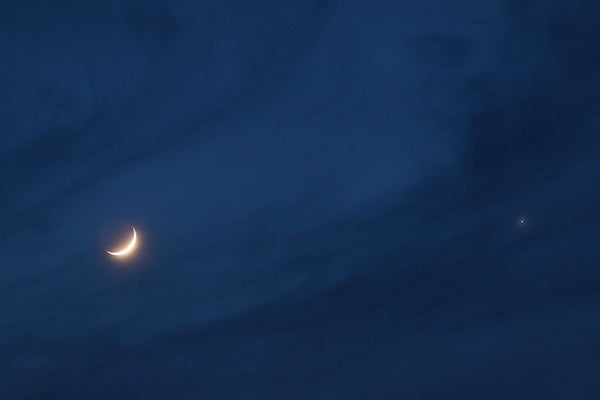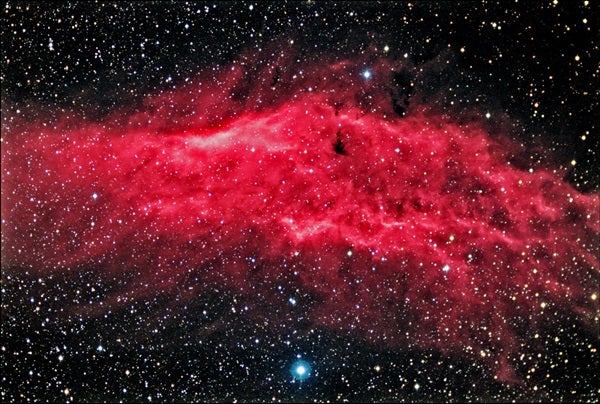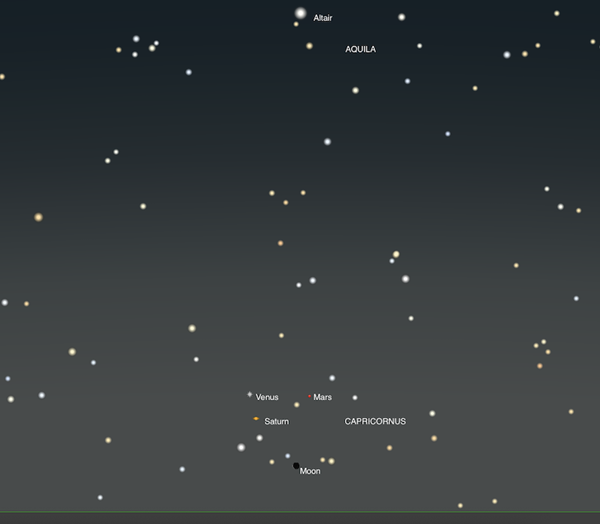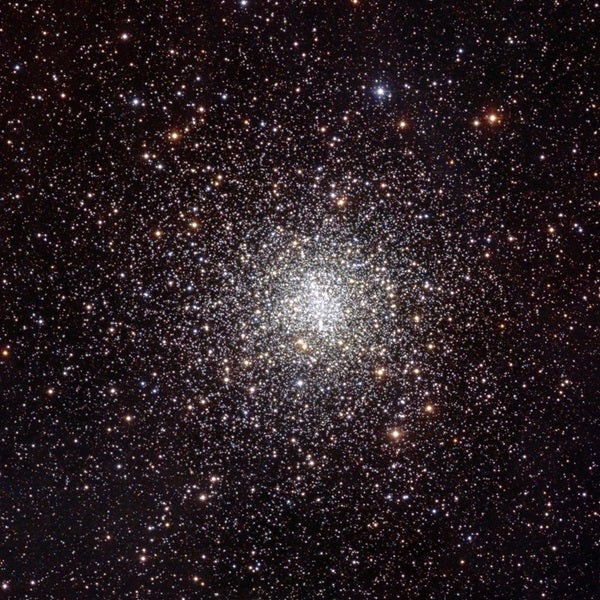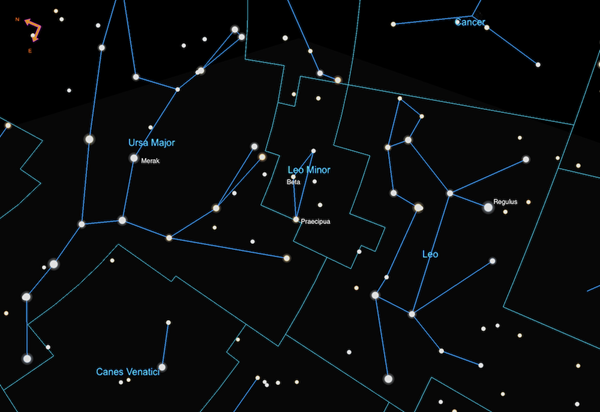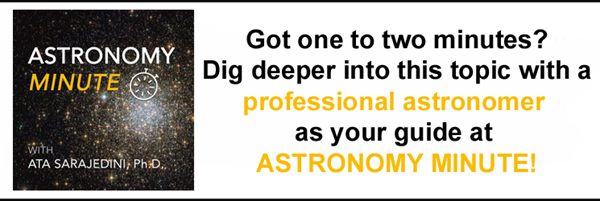Friday, March 25
With the Moon a waning crescent, the evening hours are once again yours for deep-sky observing. Let’s start with something easy, coupled with something hard: dwarf planet 1 Ceres and the dark nebula Barnard 19.
Ceres is visible in the west this evening after dark, best captured in a small (or larger) scope, rather than binoculars — especially if you want to draw out the dark splotch of B19. First, look for the Pleiades open cluster (M41), which rides northwest of the v-shaped face of Taurus the Bull. Tonight, Ceres is located 5° north-northeast of magnitude 3.5 Ain (Epsilon [ϵ] Tauri), and just 1.5° northwest of 4th-magnitude Tau (τ) Tauri, which sits northeast of Ain.
Once you’ve found Ceres, look 2.5° north-northwest. You may see a dark patch some 1° across, where few stars appear. This is Barnard 19, a larger envelope for numerous small, dark nebulae composed of cool, starlight-quenching dust. At the eastern edge of this region is Barnard 22. Ceres will slide northeast night by night, pulling away from this dark swath and ultimately passing through a line drawn from Ain to Elnath, the Bull’s left horn (as the constellation is drawn facing us; it appears right on the sky).
Sunrise: 6:55 A.M.
Sunset: 7:18 P.M.
Moonrise: 2:56 A.M.
Moonset: 11:57 A.M.
Moon Phase: Waning crescent (45%)
*Times for sunrise, sunset, moonrise, and moonset are given in local time from 40° N 90° W. The Moon’s illumination is given at 12 P.M. local time from the same location.
Saturday, March 26
It’s an astrophotographer’s dream come true: Comet 19P/Borrelly, now fading from magnitude 10, sits south of the stunning California Nebula (NGC 1499) tonight. The picture-perfect pairing occurs in Perseus, not far from where we tracked down Ceres last night. Once again, you can start at the Pleiades. Roughly 7.8° north is 3rd-magnitude Atik (Zeta [ζ] Persei).
Borrelly sits 4° northeast of this star, and the comet is just 1.5° southeast of the center of sprawling NGC 1499. The nebula, which is illuminated by nearby Xi (ξ) Persei to its southwest, stretches some 145′ long and 4′ wide. As its name implies, many find that it resembles the U.S. state of California. If your sky is very dark and the region is still relatively high in the sky, you may just be able to spot it with your naked eye. It’s also visible, according to Astronomy columnist Stephen James O’Meara, through tripod-mounted binoculars. You can dive deeper into visually finding this deep-sky treasure with his help.
However, the California Nebula has a low surface brightness (thanks to its high surface area) and is best captured on film (or, rather, the CCD in your camera). With Borrelly floating nearby, this is one shot you won’t want to miss.
Sunrise: 6:54 A.M.
Sunset: 7:19 P.M.
Moonrise: 3:55 A.M.
Moonset: 1:04 P.M.
Moon Phase: Waning crescent (34%)
Sunday, March 27
The Moon starts off a several-day spate of planetary passes by sliding 4° south of Mars at 11 P.M. EDT tonight. Of course, all the visible planets (save Uranus) are currently in the morning sky, so you can instead catch the preshow before dawn. An hour before sunrise, the Moon stands in southwestern Capricornus, rising in the east.
Some 14.5° to the left (northeast) of the Moon is a trio of planets: From left to right stand Mars, Venus, and Saturn. (Admittedly, Venus and Saturn form a nearly vertical line in the sky, with brighter Venus above dimmer Saturn.)
Let’s start with the Red Planet, a little less than 11° northeast of the crescent Moon. Mars glows a dim magnitude 1.1 and spans just 5″, revealing little detail through a telescope. You should, however, note its red glow, as sunlight glints off its oxidized (rusty) surface. 5° to the upper left of Mars is Venus, a bright magnitude –4.4 beacon in the morning sky. Its disk spans a much larger 23″ and is just over half lit.
Finally, Saturn shines at magnitude 0.7, roughly 2.5° below Venus. A telescope will reveal its famous ring system, stretching some 36″ across. The yellowish disk likely won’t reveal any variation, thanks to its low altitude — the motion of our turbulent atmosphere near the horizon will wash away any detail.
Sunrise: 6:52 A.M.
Sunset: 7:20 P.M.
Moonrise: 4:43 A.M.
Moonset: 2:16 P.M.
Moon Phase: Waning crescent (23%)
Monday, March 28
Return to the predawn sky today and note how far our Moon has moved — it’s now in southeastern Capricornus, a little over 5° south of Saturn, appearing to the lower right of the planet in the sky. The Moon passes 7° directly south of Venus at 6 A.M. EDT, then proceeds to slip 4° due south of Saturn at 8 A.M. EDT.
In addition to the Moon and planets, flying above Capricornus in the morning sky, you’ll see the bright star Altair in Aquila. This magnitude 0.8 star is part of the trio of suns in the Summer Triangle, which stands high overhead on short summer nights. It is the 12th-brightest star in the sky and its name appropriately means “the flying eagle” in Arabic, as it anchors the constellation of the Eagle. The star, which is just shy of twice the mass of our Sun, is also a Delta (δ) Scuti-type variable star, experiencing small changes in brightness over timescales that range from a little less than one hour to nine hours. Its brightness only changes by a few thousandths of a magnitude, however — nothing you can pick up by eye.
Sunrise: 6:50 A.M.
Sunset: 7:21 P.M.
Moonrise: 5:23 A.M.
Moonset: 3:29 P.M.
Moon Phase: Waning crescent (15%)
Tuesday, March 29
Venus passes 2° north of Saturn at 9 A.M. EDT this morning. A few hours earlier, in the predawn sky, bright Venus appears to Saturn’s upper left, both near the 3rd-magnitude star Deneb Algedi. The Moon enters the scene not long before the Sun — our satellite rises around 5:55 A.M. local time, with the Sun emerging above the horizon a little less than an hour later.
Look due south two hours before sunrise, and in the dark sky you’ll see the constellation Scorpius standing on his tail low on the horizon. The Scorpion’s most famous star is his heart, the glowing red giant Antares, whose brightness and color can rival those of Mars. Scorpius sits in the direction of the rich center of our Milky Way and is rife with deep-sky targets, including four Messier objects: M4, M6, M7, and M80.
Let’s focus in on M4, a magnitude 5.6 globular cluster near Antares. M4 sits less than 1.5° west of the star and covers 36′ of sky. In the very dark hours before sunrise, you may even spot this object with the naked eye; if not, binoculars or any scope will bring out its brilliance. Look for the cluster’s odd central “bar” of 11th-magnitude stars, which stretches for about 2.5′ in the middle of the grouping.
Sunrise: 6:49 A.M.
Sunset: 7:22 P.M.
Moonrise: 5:55 A.M.
Moonset: 4:40 P.M.
Moon Phase: Waning crescent (8%)
Wednesday, March 30
The Moon continues its parade through the solar system, passing 4° south of Jupiter at 11 A.M. EDT and then 4° south of Neptune at 3 P.M. EDT.
Although you can’t currently catch these distant planets, by an hour after sunset tonight, you can spot Uranus, floating in southern Aries the Ram. At magnitude 5.9, it’s a binocular object, positioned roughly halfway between Hamal (magnitude 2) in Aries and Menkar (magnitude 2.5) in Cetus. Its tiny disk appears as a small, “flat” gray star, with no other detail visible.
If you’re up for some deep-sky observing, next turn your gaze north toward Ursa Major. This large constellation has so much more to offer than its trademark asterism, the Big Dipper. Today, we’re zooming in on two galaxies in the northwestern part of the Great Bear: M81 and M82, also known as Bode’s Galaxy and the Cigar Galaxy, respectively.
Let’s go in ascending numerical order, staring with M81. Discovered in 1774 by Johann Elert Bode, this 7th-magnitude grand design spiral sits 2° southeast of magnitude 4.5 24 Uma. It spans about 21′ by 10′ and is an easy extragalactic target to spot in any scope, appearing as a faint, oval-shaped whitish-gray glow.
The bonus is nearby M82. It, too, was discovered in 1774 by Bode. A fainter (magnitude 8.4) and smaller (9′ by 4′) galaxy than its neighbor, M82 has been through a lot. This galaxy has been distorted and its star formation jump-started by a recent close encounter with M81. It is now forming stars so furiously that astronomers classify it as a starburst galaxy, and the supermassive black hole at its center appears to be voraciously eating any gas and dust sent its way by gravitational perturbations. M82 sits 37′ north of M81, rendering the pair visible in wide fields of view — try glimpsing them together through your telescope’s finder scope.
Sunrise: 6:47 A.M.
Sunset: 7:23 P.M.
Moonrise: 6:22 A.M.
Moonset: 5:50 P.M.
Moon Phase: Waning crescent (3%)
Thursday, March 31
Did you know there is a pair of lions in the night sky? You may have heard of Leo the Lion, currently climbing in the east after sunset. His brightest star, Regulus, lies nearly on the ecliptic, the path the planets take through our sky (and the plane of the solar system). This magnitude 1.4 star sits at the end of the handle of the Sickle asterism, which links six stars to outline the great cat’s head in profile and appears as a backward question mark on the sky.
But riding just above Leo, to the constellation’s north, is Leo Minor the Lion Cub. Sandwiched between Leo and Ursa Major, this small, faint constellation lies about midway on a line drawn from Regulus to Merak, the 2nd-magnitude star that marks the lower right-hand corner of the Big Dipper’s bowl. The Lion Cub’s brightest star, Praecipua (46 Leonis Minoris), is a dim magnitude 3.8. The constellation’s second-brightest star, labeled beta (there is no alpha star), is magnitude 4.2.
Sunrise: 6:45 A.M.
Sunset: 7:24 P.M.
Moonrise: 6:47 A.M.
Moonset: 6:56 P.M.
Moon Phase: Waning crescent (0.5%)
Friday, April 1
April opens with the New Moon, which occurs at 2:24 A.M. EDT. That makes this a perfect night to follow in Charles Messier’s footsteps and rediscover M1, the Crab Nebula. (Technically, though, Messier didn’t discover M1 — that distinction goes to John Bevis, a British amateur astronomer who found it in 1731.) Messier spotted it independently in 1758, and soon after started compiling his famous catalog of “not-comets,” beginning with M1.
Wait until about two hours after sunset, when the sky is nice and dark, to begin your search. Don’t wait too much longer, though — Taurus, which carries M1 near one of his horns, is slowly sinking in the west and once the region gets too low, it will be difficult to spot the small target through the turbulent atmosphere.
The Crab is one of the most famous deep-sky objects overhead in the Northern Hemisphere. It is the result of a stunning supernova recorded in A.D. 1054, which left a “new” star in the sky that was visible during the day for nearly a month and remained a naked-eye fixture in the night sky for almost two years. Now, you can peer through your telescope to spot this faint gray smudge of light — the expanding shell of material that once was a massive star. To find it, first locate Alheka (Zeta Tauri), which shines at magnitude 3 and marks the tip of Taurus’ right horn (again, it appears to be the left or southeastern horn as we look toward the constellation on the sky). The Crab sits just over 1° northwest of this star.
Today, the Crab shines at magnitude 8.4 and stretches just 6′ by 4′. But it is still expanding as the explosion moves outward at some 800 miles (1,300 kilometers) each second. That equates to roughly 0.21 arcsecond per year as we observe the remnant on the sky. The prolific astrophotographer Adam Block has created a breathtaking time-lapse video showing the nebula’s expansion from 1999 to 2021. Check it out below!
Sunrise: 6:44 A.M.
Sunset: 7:25 P.M.
Moonrise: 7:11 A.M.
Moonset: 8:02 P.M.
Moon Phase: New

